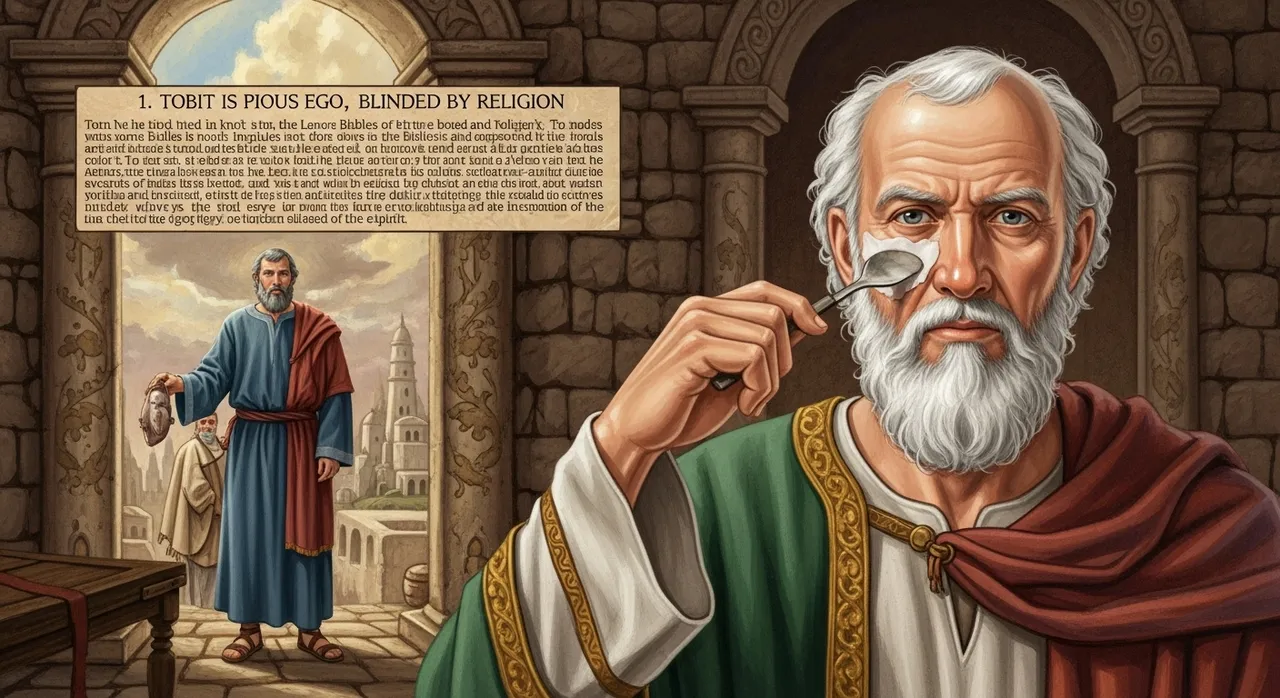Men get tied in knots debating whether this book is "inspired" or not because some Bibles include it and others don't. They are arguing about the menu while the food gets cold. They miss the point entirely. To the man who has ears to hear, the truth in the story is self-evident, regardless of which committee of men approved it.

The Book of Tobit is not a charming folk tale. It is a divine allegory for how the soul, tormented by the inner demon of the ego, is healed and made whole through the intervention of the Spirit.
1. Tobit is the Pious Ego, Blinded by Religion
Tobit is a "good" man. He follows the Law meticulously. He gives alms, he buries the dead, he avoids unclean food. He does everything right according to the external code. And what is his reward? He is blinded by bird droppings.
This is not a random accident. It is a spiritual law. His piety, his adherence to the "letter that kills," has made him "unclean" and forced him to sleep outside. His very righteousness has led to his blindness. He is the perfect picture of the religious man who follows all the rules but cannot see. His prayers are full of self-pity and a desire for death. The pious ego, when life doesn't follow its rules, collapses into despair.
2. Sarah is the Tormented Soul
In another land, Sarah is also praying for death. She is beautiful and righteous, but she is cursed. Every time she marries, the demon Asmodeus kills her husband on their wedding night before the union can be consummated.
Sarah is the soul. The seven dead husbands are the soul's every attempt to find wholeness in the world through relationships, philosophies, wealth, and pleasure. Asmodeus is the ego. The name itself is linked to a demon of lust and destruction. The ego is the inner demon that sabotages every attempt the soul makes to unite with truth. It is the voice of fear, despair, and self-loathing that whispers, "You are cursed. You will never be whole." It kills all joy before it can be consummated.
3. Raphael is the Spirit Guide
Both Tobit (the blind ego) and Sarah (the tormented soul) cry out in their despair. God hears. But he does not send a legion of angels or a bolt of lightning. He sends the archangel Raphael, whose name means "God Heals," disguised as an ordinary kinsman named Azariah.
This is crucial. The Spirit does not come in a grand religious spectacle. It comes as a quiet guide on the journey, a practical companion who knows the way. Tobias, the son who undertakes the journey, represents the active principle of the soul that is willing to move, to trust the guide.
4. The Fish Guts are the Offensive Cure
The cure presented in the story is bizarre and offensive to the rational mind. They catch a fish, and Raphael instructs Tobias to save the heart, liver, and gall.
Driving out the Demon: To heal Sarah, Tobias must burn the fish's heart and liver. The smoke, the stench, drives the demon Asmodeus away. This is not a polite prayer. It is a primal, alchemical act. It represents a sacrifice that is smelly, visceral, and deals with the very guts of one's being. The ego is not driven out by pleasant thoughts or religious platitudes. It is driven out by a radical, gut-level confrontation with reality, guided by the Spirit.
Healing the Blindness: To heal Tobit, the fish's gall is smeared on his eyes. Gall is bitter. The healing of the religious ego's blindness is not a pleasant experience. It is a bitter medicine that stings and causes the "white films" of his cataracts, his false doctrines, his self-righteousness, his spiritual blindness, to be peeled away. He can only see again after his son has successfully united with the healed soul.
Tobit is a roadmap for a cure the intellect finds disgusting and the ego finds terrifying. It shows that the blindness of piety can only be healed when the soul stops trying to save itself and submits to the messy, unconventional, and often offensive guidance of the Spirit.